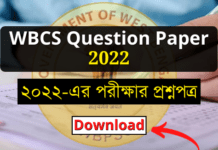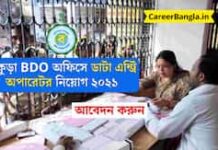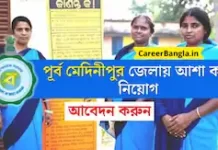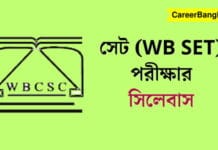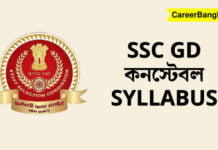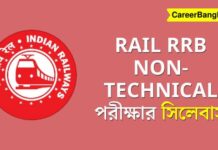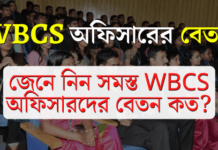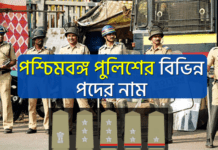WBCSC (West Bengal College Service Commission) – এর তত্ত্বাবধানে প্রতি বছর আমাদের রাজ্যে ‘SET’ অথবা State Eligibility Test exam হয়। এই পরীক্ষায় পাশ করলে পশ্চিমবঙ্গের বিভিন্ন মহাবিদ্যালয় ও বিশ্ববিদ্যালয়গুলিতে শিক্ষকতা করার সুযোগ পাওয়া যায় অ্যাসিস্ট্যান্ট টিচার হিসাবে। এই পরীক্ষাটি সাধারনত বছরে একবারই হয়। শেষ ২০২৩ সালের ৮ই জানুয়ারি এই পরীক্ষাটি হয়েছে।
UGC NET পরীক্ষার সিলেবাস ও exam pattern-এর সাথে WB SET পরীক্ষার সিলেবাস ও exam pattern-এর সাদৃশ্য লক্ষ্য করা যায়। UGC NET পরীক্ষার মত এই সেট পরীক্ষাটিকেও ২টি paper-এ ভাগ করা হয়েছে। PAPER-1 এর বিষয়বস্তু হল General Paper of Teaching Aptitude (GTA) এবং PAPER-2 তে থাকে বিষয় ভিত্তিক প্রশ্ন। এখানে আমরা ২টি paper-এর সিলেবাস নিয়ে আলোচনা করব-
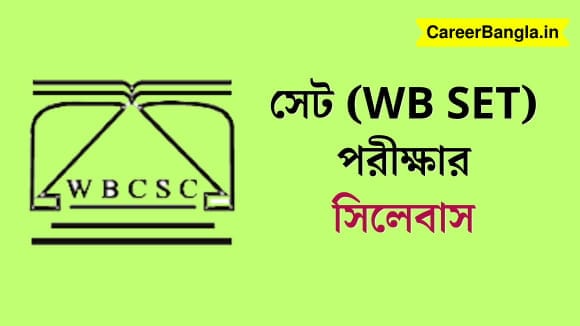

WB SET Exam Syllabus
WB SET Paper -1 Syllabus
সেট (SET) exam- এর PAPER-1 এর বিষয়বস্তু হল General Paper of Teaching (GTA)। এই GTA- এর Syllabus- টিকে যে ১০টি ভাগে বা unit-এ ভাগ করা হয়েছে, সে গুলি হল-
- I) Teaching Aptitude
- II) Research Aptitude
- III) Comprehension
- IV) Communication
- V) Mathematical Reasoning and Aptitude
- VI) Logical Reasoning (LR)
- VII) Data Interpretation (DI)
- VIII) Information Communication Technology(ICT)
- IX) People Development and Environment
- X) Higher Education System
Unit-I (Teaching Aptitude) (শিক্ষাগত যোগ্যতা):
- Teaching (শিক্ষাদান): Concept (ধারণা), Objectives (উদ্দেশ্য), Levels of teaching (Memory, Understanding and Reflective) [শিক্ষার স্তর (স্মৃতি, বোঝাপড়া এবং প্রতিফলিত)], Characteristics and basic requirements [বৈশিষ্ট্য এবং মৌলিক প্রয়োজনীয়তা]।
- Learner’s characteristics (শিক্ষার্থীর বৈশিষ্ট্য): Characteristics of adolescent and adult learners (Academic, Social, Emotional and Cognitive [কিশোর এবং প্রাপ্তবয়স্ক শিক্ষার্থীদের বৈশিষ্ট্য (একাডেমিক, সামাজিক, মানসিক এবং জ্ঞানীয়)], Individual differences (স্বতন্ত্র পার্থক্য)।
- Factors affecting teaching related to Teacher, Learner, Support material, Instructional facilities, Learning environment and Institution. (শিক্ষক, শিক্ষার্থী, সহায়ক উপাদান, নির্দেশনামূলক সুবিধা, শিক্ষার পরিবেশ এবং প্রতিষ্ঠানের সাথে সম্পর্কিত শিক্ষাকে প্রভাবিত করার কারণ)।
- Methods of teaching in Institutions of higher learning (উচ্চতর শিক্ষা প্রতিষ্ঠানে শিক্ষাদানের পদ্ধতি): Teacher centered vs Learner centered methods (শিক্ষক কেন্দ্রিক বনাম শিক্ষার্থী কেন্দ্রিক পদ্ধতি); Off-line vs On-line methods (Swayam, Swayamprabha, MOOCs etc.) [অফ-লাইন বনাম অন-লাইন পদ্ধতি (স্বয়ম, স্বয়ংপ্রভা, MOOCs ইত্যাদি)]।
- Teaching Support System (টিচিং সাপোর্ট সিস্টেম): Traditional, Modern and ICT based (ঐতিহ্যগত, আধুনিক এবং আইসিটি ভিত্তিক)।
- Evaluation Systems (মূল্যায়ন সিস্টেম): Elements and Types of evaluation (মূল্যায়নের উপাদান এবং প্রকারভেদ), Evaluation in Choice Based Credit System in Higher education (উচ্চ শিক্ষায় পছন্দ ভিত্তিক ক্রেডিট সিস্টেমের মূল্যায়ন), Computer based testing (কম্পিউটার ভিত্তিক পরীক্ষা), Innovations in evaluation systems (মূল্যায়ন পদ্ধতিতে উদ্ভাবন)।
Unit-II (Research Aptitude) (গবেষণা যোগ্যতা):
- Research (গবেষণা): Meaning (গবেষণার অর্থ), Types and Characteristics (প্রকারভেদ এবং বৈশিষ্ট্য), Positivism and Postpositivism approach to research (পজিটিভিজম এবং পোস্টপজিটিভিজম পদ্ধতি)।
- Methods of Research (গবেষণার পদ্ধতি): Experimental (পরীক্ষামূলক), Descriptive (বর্ণনামূলক), Historical (ঐতিহাসিক), Qualitative and Quantitative methods (গুণগত এবং পরিমাণগত পদ্ধতি)।
- Steps of Research (গবেষণার ধাপ)।
- Thesis and Article writing (থিসিস এবং প্রবন্ধ লেখা): Format and styles of referencing (রেফারেন্সের বিন্যাস এবং শৈলী)।
- Application of ICT in research (গবেষণায় আইসিটির প্রয়োগ)।
- Research ethics (গবেষণা নৈতিকত)।
Unit-III (Comprehension) (অনুধাবন):
A passage of text be given. Questions be asked from the passage to be answered. (যে কোনো লেখনির একটি অংশ দেওয়া হবে এবং সেই লেখনির উপর ভিত্তি করে প্রশ্ন আসবে।)
Unit-IV (Communication) (যোগাযোগ):
- Communication (যোগাযোগ): Meaning, types and characteristics of communication (যোগাযোগের অর্থ, প্রকার এবং বৈশিষ্ট্য)।
- Effective communication (কার্যকর যোগাযোগ): Verbal and Non-verbal (মৌখিক এবং অ-মৌখিক), Inter-Cultural and group communications (আন্তঃসাংস্কৃতিক এবং গোষ্ঠী যোগাযোগ), Classroom communication (শ্রেণীকক্ষ যোগাযোগ)।
- Barriers to effective communication (কার্যকর যোগাযোগে বাধা)।
- Mass-Media and Society (গণমাধ্যম ও সমাজ)।
Unit-V (Mathematical Reasoning and Aptitude) (গাণিতিক যুক্তি এবং যোগ্যতা):
- Types of reasoning (যুক্তির প্রকারভেদ)
- Number series, Letter series, Codes and Relationships (সংখ্যা সিরিজ, চিঠি সিরিজ, কোড এবং সম্পর্ক)
- Mathematical Aptitude (Fraction, Time & Distance, Ratio, Proportion and Percentage, Profit and Loss, Interest and Discounting, Averages etc.) [গাণিতিক যোগ্যতা (ভগ্নাংশ, সময় ও দূরত্ব, অনুপাত, অনুপাত এবং শতাংশ, লাভ এবং ক্ষতি, সুদ এবং ছাড়, গড় ইত্যাদি)]
Unit-VI [Logical Reasoning (LR)] [লজিক্যাল রিজনিং (এল আর)]:
- Understanding the structure of arguments: argument forms, structure of categorical propositions, Mood and Figure, Formal and Informal fallacies, Uses of language, Connotations and denotations of terms, Classical square of opposition (যুক্তির গঠন বোঝা: আর্গুমেন্ট ফর্ম, শ্রেণীবদ্ধ প্রস্তাবের গঠন, মেজাজ এবং চিত্র, আনুষ্ঠানিক এবং অনানুষ্ঠানিক বিভ্রান্তি, ভাষার ব্যবহার, শব্দের অর্থ এবং ব্যাখ্যা, বিরোধিতার ক্লাসিক্যাল বর্গ)।
- Evaluating and distinguishing deductive and inductive reasoning (ডিডাক্টিভ এবং ইনডাকটিভ যুক্তির মূল্যায়ন এবং পার্থক্য করা)।
- Analogies (উপমা)।
- Venn diagram (ভেন ডায়াগ্রাম): Simple and multiple use for establishing validity of arguments (যুক্তির বৈধতা প্রতিষ্ঠার জন্য সহজ এবং একাধিক ব্যবহার)।
- Indian Logic (ভারতীয় যুক্তিবিদ্যা): Means of knowledge (জ্ঞানের মাধ্যম)।
- Pramanas (প্রামানস): Pratyaksha (Perception) [প্রতিক্ষা (উপলব্ধি)], Anumana (Inference) [অনুমান (অনুমান)], Upamana (Comparison) [উপমনা (তুলনা)], Shabda (Verbal testimony) [শব্দ (মৌখিক সাক্ষ্য)], Arthapatti (Implication) [অর্থপট্টি (অন্তর্ভুক্তি)], Anupalabdhi (Non-apprehension) [অনুপলব্ধি (অ-শঙ্কা)]।
- Structure and kinds of Anumana (inference), Vyapti (invariable relation), Hetvabhasa (fallacies of inference) [অনুমান (অনুমান), ব্যাপ্তি (অপরিবর্তনীয় সম্পর্ক), হেত্বভাষা (অনুমানের ভুল) এর গঠন ও প্রকার]।
Unit-VII [Data Interpretation (DI)] [উপাত্ত ব্যাখ্যা করা (ডিআই)]:
- Sources, acquisition and classification of Data (তথ্যের উৎস, অধিগ্রহণ এবং শ্রেণীবিভাগ)।
- Quantitative and Qualitative Data (পরিমাণগত এবং গুণগত ডেটা)।
- Graphical representation (Bar-chart, Histograms, Pie-chart, Table-chart and Line-chart) and mapping of Data [গ্রাফিক্যাল উপস্থাপনা (বার-চার্ট, হিস্টোগ্রাম, পাই-চার্ট, টেবিল-চার্ট এবং লাইন-চার্ট) এবং ডেটা ম্যাপিং]।
- Data Interpretation ( ডেটার ব্যপারে ব্যখ্যা করা)।
- Data and Governance (ডেটা এবং গভর্নেন্স)।
Unit-VIII [Information Communication Technology(ICT)] [তথ্য যোগাযোগ প্রযুক্তি (আইসিটি)]:
- ICT (আইসিটি): General abbreviations and terminology (সাধারণ সংক্ষিপ্ত রূপ এবং পরিভাষা)।
- Basics of Internet, Intranet, E-mail, Audio and Video-conferencing (ইন্টারনেট, ই-মেইল, অডিও এবং ভিডিও-কনফারেন্সিংয়ের মৌলিক বিষয়)।
- Digital initiatives in higher education (উচ্চ শিক্ষায় ডিজিটাল উদ্যোগ)।
- ICT and Governance (আইসিটি এবং গভর্নেন্স)।
Unit-IX (People Development and Environment) (জনগণের উন্নয়ন এবং পরিবেশ):
- Development and environment (উন্নয়ন এবং পরিবেশ): Millennium development and Sustainable development goals (সহস্রাব্দ উন্নয়ন এবং টেকসই উন্নয়ন লক্ষ্যমাত্রা)।
- Human and environment interaction (মানব এবং পরিবেশের মিথস্ক্রিয়া): Anthropogenic activities and their impacts on the environment (নৃতাত্ত্বিক কার্যকলাপ এবং পরিবেশের উপর তাদের প্রভাব)।
- Environmental issues (পরিবেশগত সমস্যা): Local, Regional and Global (স্থানীয়, আঞ্চলিক এবং বৈশ্বিক); Air pollution (বায়ু দূষণ), Water pollution (জল দূষণ), Soil pollution (মাটি দূষণ), Noise pollution (শব্দ দূষণ), Waste (solid, liquid, biomedical, hazardous, electronic) [বর্জ্য (কঠিন, তরল, বায়োমেডিকাল, বিপজ্জনক, ইলেকট্রনিক)], Climate change and its Socio-Economic and Political dimensions (জলবায়ুর পরিবর্তন এবং এর আর্থ-সামাজিক ও রাজনৈতিক মাত্রা)।
- Impacts of pollutants on human health (মানব স্বাস্থ্যের উপর দূষণকারীর প্রভাব).
- Natural and energy resources (প্রাকৃতিক এবং শক্তি সম্পদ): Solar (সৌর), Wind (বায়ু), Soil (মাটি), Hydro (হাইড্রো), Geothermal (জিওথার্মাল), Biomass (বায়োমাস), Nuclear and Forests (পারমাণবিক এবং বন)।
- Natural hazards and disasters (প্রাকৃতিক বিপদ এবং দুর্যোগ): Mitigation strategies (প্রশমন কৌশল)।
Environmental Protection Act (1986) [পরিবেশ সুরক্ষা আইন (১৯৮৬)]: National Action Plan on Climate Change (জলবায়ু পরিবর্তন সংক্রান্ত জাতীয় কর্ম পরিকল্পনা), International agreements/efforts-Montreal Protocol (আন্তর্জাতিক চুক্তি/প্রচেষ্টা-মন্ট্রিল প্রোটোকল), Rio Summit (রিও সামিট), Convention on Biodiversity (কনভেনশন অন বায়োডাইভারসিটি), Kyoto Protocol (কিয়োটো প্রোটোকল), Paris Agreement (প্যারিস চুক্তি), International Solar Alliance (আন্তর্জাতিক সৌর জোট)।
Unit-X (Higher Education System) (উচ্চ শিক্ষা ব্যবস্থা):
- Institutions of higher learning and education in ancient India (প্রাচীন ভারতে উচ্চশিক্ষা ও শিক্ষার প্রতিষ্ঠান)।
- Evolution of higher learning and research in Post Independence India (স্বাধীনতা পরবর্তী ভারতে উচ্চতর শিক্ষা ও গবেষণার বিবর্তন)।
- Oriental, Conventional and Non-conventional learning programmes in India (ভারতে প্রাচ্য, প্রচলিত এবং অপ্রচলিত শিক্ষা কার্যক্রম)।
- Professional, Technical and Skill Based education (পেশাগত, কারিগরি এবং দক্ষতা ভিত্তিক শিক্ষা)।
- Value education and environmental education (মূল্যবোধ শিক্ষা এবং পরিবেশগত শিক্ষা)।
- Policies, Governance, and Administration (নীতি, শাসন, এবং প্রশাসন)।
WB SET Paper – 2 Syllabus
Paper- 2 বিষয়ের উপর ভিত্তি করে করা হয়। অর্থাৎ, যে পরীক্ষার্থী যে বিষয়ের শিক্ষক-শিক্ষিকা হতে চান সেই বিষয়ের সমস্ত প্রশ্ন Paper- 2-তে আসে। WBCSC-এর তরফ থেকে মোট ৩৩টি বিষয়কে ধার্য করা হয়েছে Paper-2-এর জন্য। সেগুলি হল-
| ১) ইংরেজি | ২) বাংলা | ৩) সংস্কৃ্ত |
| ৪) হিন্দি | ৫) উর্দু | ৬) কমার্স |
| ৭) ইকোনমিকস | ৮) ইতিহাস | ৯) দর্শন |
| ১০) রাষ্ট্রবিজ্ঞান | ১১) এডুকেশন | ১২) ভূগোল |
| ১৩) নৃতত্ত্ববিদ্যা | ১৪) ভৌতবিজ্ঞান | ১৫) জীব বিজ্ঞান |
| ১৬) ম্যাথামেটিক্যাল সায়েন্স | ১৭) মনোবিজ্ঞান | ১৮) সমাজবিজ্ঞান |
| ১৯) কম্পিউটার সায়েন্স | ২০) লাইব্রেরি অ্যান্ড ইনফরমেশন সায়েন্স | ২১) কেমিক্যাল সায়েন্স, |
| ২২) ইলেক্ট্রনিক সায়েন্স | ২৩) শারীরশিক্ষা | ২৪) সাওতালি |
| ২৫) নেপালি | ২৬) আরবিক | ২৭) সঙ্গীত |
| ২৮) আইনবিদ্যা | ২৯) মাস কমিউনিকে অ্যান্ড জার্নালিশম | ৩০) হোম সায়েন্স |
| ৩১) পৃথিবী বিজ্ঞান | ৩২) পরিবেশ বিদ্যা | ৩৩) ম্যানেজমেন্ট |
এখানে এই যে ৩৩টি বিষয় নির্দিষ্ট করে দেওয়া আছে সেই বিষয়গুলির Alling Subject-এ স্নাতকোত্তর করা প্রার্থীরাও আবেদন করতে পারবেন। সহজ ভাষায় বলতে গেলে কোনো পরীক্ষার্থী যদি Public Administration বা International Relationship নিয়ে স্নাতকোত্তর করেন তাহলে তিনি রাষ্ট্রবিজ্ঞান বিষয়টিকে Paper-2 এর বিষয় হিসাবে নির্বাচন করতে পারেন। আবার কোনো পরীক্ষার্থী যদি Botany, Zoology নিয়ে স্নাতকোত্তর করেন তাহলে তিনি জীববিজ্ঞান বিষয়টিকে Paper-2 এর বিষয় হিসাবে নির্বাচন করতে পারেন। এইভাবে Geology-তে স্নাতকোত্তর করা পরীক্ষার্থীরা পৃথিবী বিজ্ঞান বিষয়টিকে, রসায়ন ও পদার্থবিদ্যায় স্নাতকোত্তর করা পরীক্ষার্থীরা ভৌতবিজ্ঞান বিষয়টিকে Paper-2-এর বিষয় হিসাবে নির্বাচন করতে পারেন।

